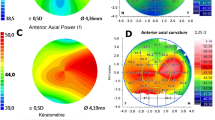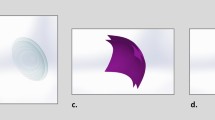Abstract
Purpose
The purpose of this study was to investigate the relation of the corneal ink mark size, shape, and location with the corneal perimeter in terms of the corresponding corneal axis.
Material and methods
This study was designed both prospective experimental and literature search. Contact lenses were used to demonstrate the spreading effect of the surgical ink mark. Open-access published corneal images with corneal ink marks were reviewed. Mark size and perimeter of both contact lenses and corneal images were performed in Image J software.
Results
Twenty contact lenses and 15 corneal images with 32 corneal marks, which were obtained from the literature, were included in the study. Mean degree corresponding to the ink size for the group 1 was 8.3° ± 1.2° (range 5.5–10.3), for group 2 was 11° ± 1.1° (range 8–12), for group 3 was 4.2° ± 0.7° (range 3.2–5.5), for group 4 was 4.2° ± 0.7° (range 3.2–5.5), and for group 5 was 6.3° ± 2.5° (range 2–11.5).
Discussion
Theoretically, it is wise to target further located ink mark from central cornea based on the 360/2π × (r2 − r1)/(r1 × r2) × M formula. It has been experimentally shown that the smaller corneal perimeter and closer mark to the central cornea may lead the more significant deviation from the targeted axis. Preoperative manual corneal marking may be more responsible for residual astigmatism than it is thought.




Similar content being viewed by others
References
Hoffmann PC, Hütz WW (2010) Analysis of biometry and prevalence data for corneal astigmatism in 23,239 eyes. J Cataract Refract Surg 36:1479–1485
Prasher P, Sandhu JS (2017) Prevalence of corneal astigmatism before cataract surgery in Indian population. Int Ophthalmol 37:683–689. https://doi.org/10.1007/s10792-016-0327-z
Mohammadi M, Naderan M, Pahlevani R, Jahanrad A (2016) Prevalence of corneal astigmatism before cataract surgery. Int Ophthalmol 36:807–817
Lane SS, Ernest P, Miller KM, Hileman KS, Harris B, Waycaster CR (2009) Comparison of clinical and patient-reported outcomes with bilateral AcrySof toric or spherical control intraocular lenses. J Refract Surg 25:899–901
Raucau M, El Chehab H, Agard E, Lagenaite C, Dot C (2018) Toric lens implantation in cataract surgery: automated versus manual horizontal axis marking, analysis of 50 cases. J Fr Ophtalmol 41(1):e1–e9. https://doi.org/10.1016/j.jfo.2017.11.002
Carey PJ, Leccisotti A, McGilligan VE, Goodall EA, Moore CBT (2010) Assessment of toric intraocular lens alignment by a refractive power/corneal analyzer system and slitlamp observation. J Cataract Refract Surg 36:222–229
Visser N, Berendschot TTJM, Bauer NJC, Jurich J, Kersting O, Nuijts RMMA (2011) Accuracy of toric intraocular lens implantation in cataract and refractive surgery. J Cataract Refract Surg 37:1394–1402
Grohlich M, Miháltz K, Lasta M et al (2017) Evaluation of postoperative astigmatism correction and postoperative rotational stability of two toric intraocular lenses. Klin Monbl Augenheilkd 234:796–804
Titiyal JS, Kaur M, Jose CP, Falera R, Kinkar A, Bageshwar LM (2018) Comparative evaluation of toric intraocular lens alignment and visual quality with image-guided surgery and conventional three-step manual marking. Clin Ophthalmol 12:747–753. https://doi.org/10.2147/OPTH.S164175
Solomon KD, Sandoval HP, Potvin R (2019) Correcting astigmatism at the time of cataract surgery: toric IOLs and corneal relaxing incisions planned with an image-guidance system and intraoperative aberrometer versus manual planning and surgery. J Cataract Refract Surg 45(5):569–575. https://doi.org/10.1016/j.jcrs.2018.12.002
Bayramlar H, Dag Y, Karadag R et al (2017) An easy and practical method for toric intraocular lens implantation: marking corneal astigmatic axis at slit-lamp. Int Ophthalmol 37:179–184. https://doi.org/10.1007/s10792-016-0250-3
Roumeliotis G, Hutnik C (2012) A simple reproducible and cost effective axis marking system for toric lens implantation. J Refract Surg 28:12–13
Popp N, Hirnschall N, Maedel S et al (2012) Evaluation of 4 corneal astigmatic marking methods. J Cataract Refract Surg 38:2094–2099
Igarashi A, Kamiya K, Shimizu K (2013) Clinical evaluation of accuracy of horizontal meridian limbal marking. Optom Vis Sci 90:540–545
Lin HY, Fang YT, Chuang YJ, Karlin JN, Chen HY, Lin SY, Lin PJ, Chen M (2017) A comparison of three different corneal marking methods used to determine cyclotorsion in the horizontal meridian. Clin Ophthalmol 11:311–315
Farooqui JH, Koul A, Dutta R, Shroff NM (2016) Comparison of two different methods of preoperative marking for toric intraocular lens implantation: bubble marker versus pendulum marker. Int J Ophthalmol 9:703–706
Hill W, Potvin R (2008) Monte Carlo simulation of expected outcomes with the Acrysof toric intraocular lens. BMC Ophthalmol 8:22
Jordan A, Baum J (1980) Basic tear flow. Does it exist? Ophthalmology 87:920
The definition and classification of dry eye disease: report of the definition and classification subcommittee of the international dry eye workshop (2007), vol 5, no 2, pp 75–92
Author information
Authors and Affiliations
Corresponding author
Ethics declarations
Conflict of interest
There is no conflict of interest to declare.
Additional information
Publisher's Note
Springer Nature remains neutral with regard to jurisdictional claims in published maps and institutional affiliations.
Rights and permissions
About this article
Cite this article
Aytogan, H. Effect of corneal marking features on toric intraocular lens alignment. Int Ophthalmol 40, 1653–1658 (2020). https://doi.org/10.1007/s10792-020-01333-4
Received:
Accepted:
Published:
Issue Date:
DOI: https://doi.org/10.1007/s10792-020-01333-4




